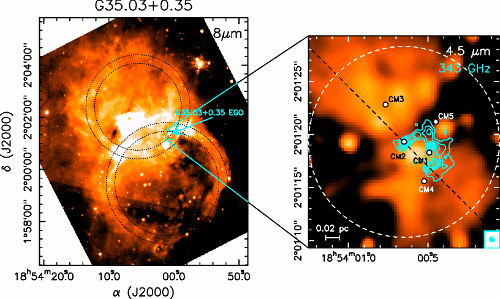Filamentary structure and Keplerian rotation in the high-mass star-forming [...] (Betran et al
- Details
- Published on 31 October 2014
Vol. 571
In section 6. Interstellar and circumstellar matter
Filamentary structure and Keplerian rotation in the high-mass star-forming region G35.03+0.35 imaged with ALMA
 Do massive stars form like low-mass stars? Massive stars play a fundamental role in the ecosystem of a galaxy, but because they are rare, little is known about the details of the their formation, at least in comparison to the formation of their lower mass siblings. Beltran et al. use ALMA observations of G35.03+0.35, the likely birth place of a B-type protostar, and find a filamentary structure fragmented into cores. One of them is core A, which harbors a hypercompact HII region. Position-velocity plots of the velocity gradient toward core A show clear signatures of Keplerian rotation and are consistent with the pattern of an edge-on Keplerian disk rotating about a star with a mass in the range 5–13 Msun. This result supports theoretical scenarios according to which high-mass stars, at least B-type stars, form through disk-mediated accretion.
Do massive stars form like low-mass stars? Massive stars play a fundamental role in the ecosystem of a galaxy, but because they are rare, little is known about the details of the their formation, at least in comparison to the formation of their lower mass siblings. Beltran et al. use ALMA observations of G35.03+0.35, the likely birth place of a B-type protostar, and find a filamentary structure fragmented into cores. One of them is core A, which harbors a hypercompact HII region. Position-velocity plots of the velocity gradient toward core A show clear signatures of Keplerian rotation and are consistent with the pattern of an edge-on Keplerian disk rotating about a star with a mass in the range 5–13 Msun. This result supports theoretical scenarios according to which high-mass stars, at least B-type stars, form through disk-mediated accretion.

